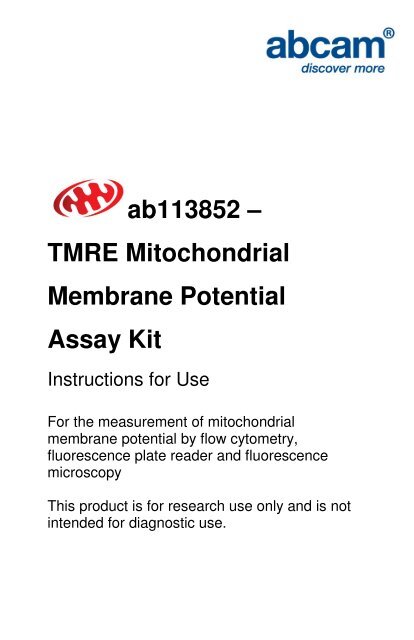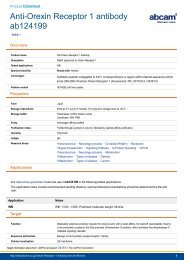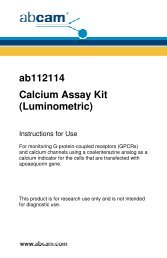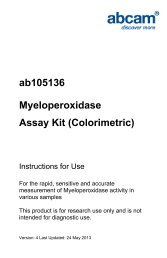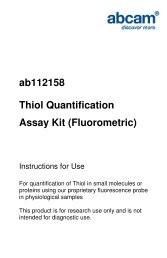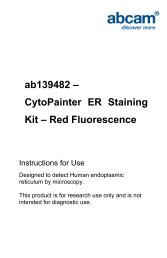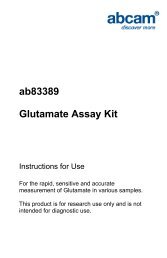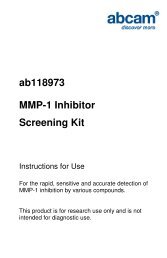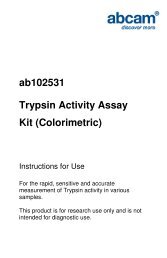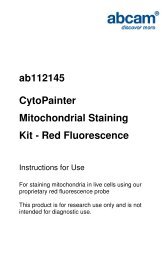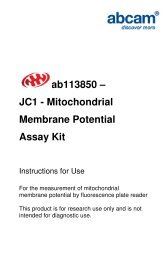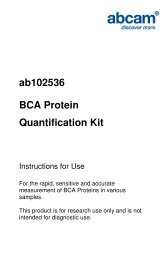TMRE Mitochondrial Membrane Potential Assay Kit - Abcam
TMRE Mitochondrial Membrane Potential Assay Kit - Abcam
TMRE Mitochondrial Membrane Potential Assay Kit - Abcam
Create successful ePaper yourself
Turn your PDF publications into a flip-book with our unique Google optimized e-Paper software.
ab113852 –<strong>TMRE</strong> <strong>Mitochondrial</strong><strong>Membrane</strong> <strong>Potential</strong><strong>Assay</strong> <strong>Kit</strong>Instructions for UseFor the measurement of mitochondrialmembrane potential by flow cytometry,fluorescence plate reader and fluorescencemicroscopyThis product is for research use only and is notintended for diagnostic use.
Table of Contents1. Introduction 32. <strong>Assay</strong> Summary 53. <strong>Kit</strong> Contents 64. Storage and Handling 65. Additional Materials Required 76. <strong>Assay</strong> Procedure 87. Sample Data 122
1. Introduction<strong>TMRE</strong> is suitable for interrogating mitochondrial membrane potentialin live cells for analysis by flow cytometry, microplatespectrophotometry and fluorescent microscopy. Each assay kitcontains sufficient materials for at least 200 measurements.<strong>Mitochondrial</strong> membrane potential (∆ψm) is highly interlinked tomany mitochondrial processes. The ∆ψm controls ATP synthesis,generation of ROS, mitochondrial calcium sequestration, import ofproteins into the mitochondrion and mitochondrial membranedynamics. Conversely, ∆ψm is controlled by ATP utilization,mitochondrial proton conductance, respiratory chain capacity andmitochondrial calcium. Hence pharmacological changes in ∆ψm canbe associated with a multitude of other mitochondrial pathologicalparameters which may require further independent evaluation.Depolarization can be found in the presence of ionophores that couldinduce nonselective cation channels or become selective mobileionic carriers. Protonophores such as FCCP and CCCP inducereversal of the ATPase, as a compensatory mechanism that tries tomaintain ∆ψm, which will deplete ATP even in the presence of anormal glycolytic pathway. Hyperpolarization could be found in thepresence of ATPase inhibition, inadequate supply of ADP, increasedsupply of NADH, apoptosis due to oxidative stress and potentially3
proton slippage due to cytochrome c oxidase dephosphorylation. Ineither scenario, OXPHOS uncoupling ensues.Principle: This mitochondrial membrane potential kit uses <strong>TMRE</strong>(tetramethylrhodamine, ethyl ester) to label active mitochondria.<strong>TMRE</strong> is a cell permeant, positively-charged, red-orange dye thatreadily accumulates in active mitochondria due to their relativenegative charge. Depolarized or inactive mitochondria havedecreased membrane potential and fail to sequester <strong>TMRE</strong>.FCCP (carbonyl cyanide 4-(trifluoromethoxy)phenylhydrazone) is aionophore uncoupler of oxidative phosphorylation. Treating cellswith FCCP eliminates mitochondrial membrane potential and <strong>TMRE</strong>staining.<strong>TMRE</strong> is suitable for the labeling of mitochondria in live cells and isnot compatible with fixation.Limitations:• FOR RESEARCH USE ONLY. NOT FOR DIAGNOSTICPROCEDURES.• Use this kit before expiration date.• Do not mix or substitute reagents from other lots or sources.• Any variation in operator, pipetting technique, washingtechnique, incubation time or temperature, and kit age cancause variation in binding.4
2. <strong>Assay</strong> SummarySeed cell line(s) and add treatment(s) for desired amount of timeOptional: 10min before adding <strong>TMRE</strong> (next step), add 100nM FCCPto one sample in mediaBring <strong>TMRE</strong> to room temperatureAdd <strong>TMRE</strong> to cells in media to final concentration of 50-1000nMIncubate 20min at 37 °CMeasure <strong>TMRE</strong> staining of mitochondria in live cells.[peak exitation=549nm, peak emission=575nm]5
For Flow cytometry: collect data from single cell suspension in mediaor 0.2% BSA in PBS.For Fluorescence plate reader: wash cells once with 0.2% BSA inPBS, then read cells in a microplate.For Fluorescence microscope: wash cells once with PBS, thenimage live cells.3. <strong>Kit</strong> Contents• 1mM <strong>TMRE</strong> (in DMSO) (~1000x) : 0.04 mL• 50mM FCCP (in DMSO) (~2500x) : 0.01 mL4. Storage and HandlingStore all components at 4°C in the dark. The kits are stable for atleast 6 months from receipt. For longer term storage, keep at -20°C.6
5. Additional Materials Required• Flow cytometer and/or fluorescence microscope (requiredexcitation/emission wavelengths 485nm/535nm)• General tissue culture supplies• PBS (sterile)• Bovine serum albumin (BSA)7
6. <strong>Assay</strong> Procedure1. Treat cells of interest with compounds, cultureconditions or other manipulation of interest.a. Treatment times can vary depending on theexperiment at hand. For example, chemicaluncouplers essentially act instantaneously (e.g.FCCP can depolarize mitochondria within minutes).In contrast, treatments that may have a less directeffect on the mitochondrial electron transport chainor that require changes in protein synthesis oractivation may take longer to manifest a change inmitochondrial membrane potential.b. Control compound FCCP. Add 20µM FCCP to cellsin media 10 minutes prior to staining with <strong>TMRE</strong>(step 2). FCCP is an uncoupler that will eliminatethe mitochondrial membrane potential and preventstaining by <strong>TMRE</strong>.2. Add <strong>TMRE</strong> to cells in culture and incubate for 15-30minutes.a. <strong>TMRE</strong> should be added to cells in media. Anefficient means to do this is to prepare a 10-20Xworking solution of <strong>TMRE</strong> in the appropriate media8
and overlay this to the experimental cultures suchthat the final concentration is 1X.b. Return cells to incubator and culture for anadditional 10-30 minutes.3. Data collection and analysisMicroplate assay:i. Removing the culture media is required to eliminatebackground fluorescence from the media:• Suspension cells: Gently pellet the cells bycentrifugation and remove the culture media.Resuspend in a like volume of 0.2% BSA in PBSand pellet again. Resuspend in 0.2% BSA inPBS and transfer to microplate.• Adherent cells: Cells should be seeded inmicroplates and allowed to adhere prior to the<strong>TMRE</strong> staining. After <strong>TMRE</strong> staining, gentlyaspirate the media and replace with 0.2% BSAin PBS. Repeat.ii.Read the plate on a fluorescence plate reader withsettings suitable for <strong>TMRE</strong> (Ex: 549nm, Em: 575nm).iii. Guidelines for cell numbers: For suspension cells,100,000 - 200,000 cells per well in 100-200µL shouldprovide sufficient signal. For adherent cells, culture9
such that the cells are not overly confluent at the timeof data collection. The user will need to determineoptimal cell densities for the given cell lines.iv.Guidelines for <strong>TMRE</strong> concentration: Dependent on thecell line at hand. Recommending startingconcentrations to test are 200-1000nM <strong>TMRE</strong>.v. Black wall microtiter plates are recommended.Flow cytometry:i. Removing media as described above for the microplatereader is not required; however, we do find anenhancement (in some cases up to 40%) of <strong>TMRE</strong>fluorescence relative to background if the media hasbeen exchanged for 0.2% BSA in PBS. The usershould determine if washing away the media benefitstheir analysis.ii.Before assessing cells by flow cytometry, be certainthat the samples are non-aggregated and in a singlecell solution. For adherent cells this will requiretrypsinization or other means to remove cells from theirculture vessel.iii. Guidelines for cell numbers: Ideally 10,000 cellsshould be analyzed and cells should not be overlydense during the experiment (
suspension cells and not overly-confluent for adherentcells).iv.Guidelines for <strong>TMRE</strong> concentration: Dependent on thecell line at hand. Starting concentrations to test are50-400nM <strong>TMRE</strong>.v. <strong>TMRE</strong> is excited by the 488nM laser and should bedetected in the appropriate filter channel (peakemission is 575nm). This is commonly FL2.Microscopy:i. Cells should be plated in a manner consistent with theavailable microscope setup for live cell imaging. Cellsshould be imaged as quickly as possible after beingremoved from the culture conditions as mitochondrialmorphology and function is dependent on temperatureand cell health. It is recommended to remove media bya PBS rinse before imaging cells to avoid backgroundcaused by the media.ii. Guidelines for <strong>TMRE</strong> concentration: 50-200nM, asdetermined by the user. It is recommended to use theleast amount of <strong>TMRE</strong> that gives a reasonablydetectable signal.iii.Use appropriate filter set for <strong>TMRE</strong>.11
ii.Flow cytometry:Figure 2. Analysis of <strong>TMRE</strong> staining by flow cytometry. Flowcytometry histogram of Jurkat cells stained with 100nM <strong>TMRE</strong> with(blue) or without (red) treatment with 100nM FCCP.13
iii.Microscopy:A. B.Figure 3. Fluroescence microscopy of <strong>TMRE</strong> labeledmitochondria in live cells. A. HeLa cells (adherent) were culturedon coverslips and stained with 200nM <strong>TMRE</strong> for 20 minutes inmedia, washed briefly with PBS and immediately imaged. B. Jurkatcells (suspension) were stained and washed as above and thentransferred to a slide and immobilized under a coverslip for imaging.14
UK, EU and ROWEmail: technical@abcam.comTel: +44 (0)1223 696000www.abcam.comUS, Canada and Latin AmericaEmail: us.technical@abcam.comTel: 888-77-ABCAM (22226)www.abcam.comChina and Asia PacificEmail: hk.technical@abcam.comTel: 108008523689 ( 中 國 聯 通 )www.abcam.cnJapanEmail: technical@abcam.co.jpTel: +81-(0)3-6231-0940www.abcam.co.jpCopyright © 2012 <strong>Abcam</strong>, All Rights Reserved. The <strong>Abcam</strong> logo is a registered trademark. 15All information / detail is correct at time of going to print.


